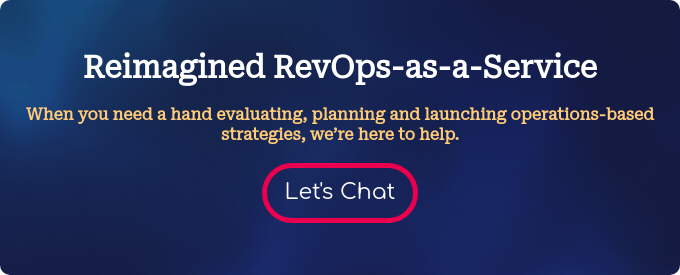In a completely unscientific study conducted by the Impulse Creative revenue team, we found that the best way for our CRM updates to “stick” with our users was to make them as fun as possible. And in the spirit of being Swifties, we turned to Taylor during a Cruel Summer of CRM cleanup and found that she’s got some great sales operations advice that improved our own HubSpot CRM setup.
If you’re Ready For It, we’d like to share.
1. Question...?
When Taylor Swift said, “Can I ask you a question?” she was right; you’ll never know if you don’t ask. Finding your customers' pain points is best accomplished by listening to them directly. You can better comprehend and address customers' problems by asking intentional questions and paying close attention to their answers.
Remember, reps should listen to understand, not to respond. That means they should be absorbing and clarifying information, not rushing through a list of questions and spending their time thinking about what they’ll ask next.
Consider asking your prospects open-ended questions to learn more about their challenges:
- What would a successful year of business look like to you? How would you feel? Your team?
- Tell me more about why your customers choose your company over competitors.
- What are some of the main challenges you experience daily?
- What are your goals for this quarter, this year, in five years?
- What is currently stopping you from achieving your goals?
- What have you done to address your challenges so far?
- What deadlines and KPIs are set for you/your company?
- What are your desired outcomes for working with me/us?
To define your own list of questions, you can use methods like focus groups, interviews, and surveys to get data about your customers. There’s also great value in rewatching old sales calls to find commonalities in conversations with prospects in your ideal customer profile (ICP).
Of course, questions like these aren’t just notes on the back of a napkin – they should be a part of your CRM… and not just in an email or an agenda but in a HubSpot Playbook… more on that in a minute.
2. It's Nice to Have a Friend
Conducting discovery calls doesn’t have to be awkward. While building rapport and asking open-ended questions can be a challenge, defining a method for your team’s discovery process can overcome that awkwardness and help your reps write your prospects’ next story.
Of course, any sales manager or sales ops pro knows that defining the process and actually getting users to follow it are two completely separate efforts.
That's why we write our stories in HubSpot Playbooks. Playbooks give you a way to structure your discovery calls into consistent conversations. This reminds reps of the ground they need to cover and gives them the confidence to focus on the prospect’s story, enabling them to better:
- Identify pain points
- Handle objections
- Ask critical questions
- Lead with empathy
- Direct next steps to be taken
- Understand when and how to follow up to nurture prospects properly
How can a CRM feature do that? While features don’t replace process and training, let’s break down one of our own HubSpot playbooks to see how the right structure can make your reps Fearless.
Our playlist is called “LAZER,” which stands for the steps the playbook takes the rep through: Listen, Acknowledge, Zip it, Explore, and Respond.
Our Director of Sales and Marketing, Molly, created this playbook because she noticed a gap between the goals of the seller and the goals of the buyer.
Historically, the seller has wanted to push a product, and the buyer wants to solve a problem.
Enter: solution selling - building a comprehensive story around your prospects’ most important challenges and pain points as they align to their goals.
The following examples prioritize getting to know the prospect (really getting to know the prospect), acknowledging and empathizing with the prospect’s pain points, and then recommending the best-fit solution.




When your sales reps are able to focus on your prospects’ stories, instead of the nitty-gritty of running a call and taking notes, they’re more likely to be engaged in the conversation and build a deeper, more fruitful relationship.
As a bonus, if you set up your Playbook with contact or deal properties, any data your reps add will automatically update your CRM, which lets those reps spend more time on more relationships (instead of CRM administration).
3. I Know Places
You should taylor tailor your questions and responses to the individual's needs as you gain their trust and hear out their points of view.
Keep in mind that in the sales process, you are a helpful guide pointing your prospects towards the best solution for their goals.
For example, if your product has several uses, let customers know which of the features addresses the prospect's goals based on previous conversations you’ve had. Provide guidance on how your product or solutions’ features solve those specific pain points, then provide “Yes, and…” value and show how the initiatives might expand in the future.
4. Help Me Hold On to You
As you might expect, not every engagement between a sales rep and a prospect is a straight line – sometimes, we have to hold on and nurture prospects outside of our sales conversations. In those cases, helping can be one of the most effective tactics.
When it’s time to incorporate this kind of nurturing, be sure to:
- Share resources that are hyper-relevant to what you’ve learned about your prospect and their goals.
- Create personalized communication when sharing that content, not broad marketing emails.
- When possible, track your email communication with sales enablement tools (We’re looking at you, Sales Hub!).
- Share context when you have resources that helped another client with a similar problem.
- Ask for a follow-up or next step to help keep your relationship in alignment.
5. Can't Turn Back Now, I'm Haunted
Everyone misses a meeting now and then, so there’s no need to panic or give up if a prospect ghosts you and misses a scheduled meeting. Instead, if you find yourself in this position, there are several HubSpot features to help get the meeting back on the books and the client back on track:
- Allow prospects to book meetings on their terms with the HubSpot scheduling tool.
- Embed your calendar on your website, allowing your clients to easily book a meeting with you.
- Connect your Google Calendar or Office 365 Calendar to sync availability in real time.
6. Speak Now
Just as missed meetings can be haunting, the prospect that got away can be an equally terrifying ghost. However, when you use HubSpot Marketing Hub alongside your sales efforts, you’ll be able to track the way users engage with your website and use that information to revive dead deals and get your prospects to Speak (Now) up.
Think about this strategy like e-commerce cart abandonment emails: When you’re shopping online and leave something in your cart, you often receive an email from the retailer asking you to come back and purchase, sometimes even offering you a discount. With visitor tracking in HubSpot, your reps will know when their prospects re-visit the website. They can manually reach out when they receive revisit notifications, or you can use Workflows to automate this outreach and coincidentally send an email a few hours after the prospect is on site.
Here’s an example:

This abandoned cart workflow starts with checking a user's page view and behavior.

With this advice, you'll soon say, "Everything Has Changed"
Are your Eyes Open to the capabilities of HubSpot and how you can transform your sales processes?
If you want to learn more about how to maximize HubSpot to improve your processes, chat with us about our RevOps philosophy.






